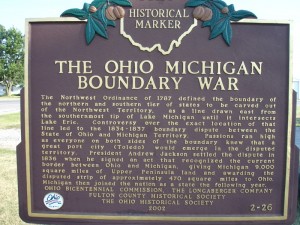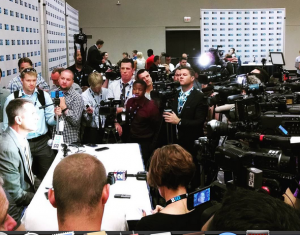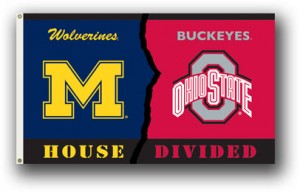This week is rivalry week in college football. Which conjures up memories of the Toledo War and the Frostbitten Convention. This weekend brings awesome games with cool names like “The Iron Bowl” (Alabama-Auburn) and “The Holy War” (BYU-Utah). But only one of these rivalry games can claim an actual war in the history of its geographic region. That’s the Michigan Wolverines vs. the Ohio State Buckeyes, or “The Game,” as it’s called.
The Toledo War is one of the many reasons ESPN Classic is running a marathon of past tOSU-UM games today.
Well, maybe two rivalries can claim actual battles: Kansas-Mizzou, given the abolitionist vs. slave state skirmishes known as “Bleeding Kansas,” in the 1850s.
Because I’m a history dork (you may have seen me on “How The States Got Their Shapes” on the History Channel, the “Great Lakes, Big Stakes” episode) who loves things with names like “The War of Jenkins Ear,” “The Era of Good Feelings” and “Merkle’s Boner.
Let me tell you about the boundary Toledo War, well it was kind of a war, more of a skirmish over the Toledo Strip between Michigan and Ohio, and the “Frostbitten Convention” that ended it.
Varying interpretations of laws passed in the late 18th and early 19th centuries caused the governments of the state of Ohio and the territory of Michigan to both claim sovereignty over a 468 square mile region along the border known as the Toledo Strip. Yes, believe it or not it was Toledo that was deemed valuable enough to fight for.
When Michigan sought statehood in the early 1830s, it’s pitch included the disputed zone it considered within its boundaries. Ohio’s Congressional delegation responded by halting Michigan’s admission to the Union.
Beginning in 1835 both sides passed legislation attempting to force the other side’s acquiescence. Relations between the two governments went from cold to openly hostile.
On July 15, 1835, tensions finally overflowed and blood was spilled. Sort of. Monroe County, Michigan Deputy Sheriff Joseph Wood went into Toledo to arrest Major Benjamin Stickney, but when Stickney and his three sons resisted, the whole family was taken into custody.
During the scuffle, Two Stickney, son of the major, stabbed Wood with a pen knife and fled south into Ohio. Wood’s injuries were not life-threatening.When Ohio Governor Robert Lucas refused Mason’s demand to extradite Two Stickney back to Michigan for trial, Mason wrote to President Jackson for help, suggesting that the matter be referred to the United States Supreme Court.
At the time of the conflict, however, the Supreme Court could resolve state boundary disputes, and Jackson declined the offer. Looking for peace, Lucas made his own efforts to end the conflict, again through federal intervention via Ohio’s congressional delegation.
In December 1836 the Michigan government, facing a dire financial crisis (I guess some things never change), surrendered the land under pressure from President Andrew Jackson and accepted a proposed resolution adopted by Congress.
Michigan had to forfeit its claim to the strip in exchange for statehood and approximately three-quarters of the Upper Peninsula.
The Toledo War, if you could call it that, some militias stared down each other and shouted at one another but only fired up into the air, not at each other. The Battle of Phillips Corner was not an actual battle.
The Toledo War ended on December 14, 1836, at a second convention in Ann Arbor. Yes the very same place that is home to UM. However, the calling of the convention was controversial. It only came about because of a public outcry. Since the legislature did not approve a call to convene, some said the congress was illegal.
Congress questioned the legality of the convention before finally accepting its solution. Because of it’s questionable nature, as well as the historical cold wave at the time, the event later became known as the “Frostbitten Convention.”
Today, conflict between the two states is limited to the Michigan–Ohio State football rivalry. This does not involve militias, muskets and pen knife wounds like you had in the Toledo War.
The Toledo area is about half and half in its allegiance, and considered the DMZ between maize and blue vs. scarlet and grey. The city has large contingents of partisans for both schools, and it’s much closer to Ann Arbor than Columbus, but it’s located in the same state as THE Ohio State University.
Paul M. Banks is the owner/manager of The Sports Bank. He’s also the author of “Transatlantic Passage: How the English Premier League Redefined Soccer in America,” and “No, I Can’t Get You Free Tickets: Lessons Learned From a Life in the Sports Media Industry.”
He’s written for numerous publications, including the New York Daily News, Sports Illustrated and the Chicago Tribune. He regularly appears on NTD News and WGN News Now, while writing for the International Baseball Writers Association of America. You can follow the website on Twitter.



